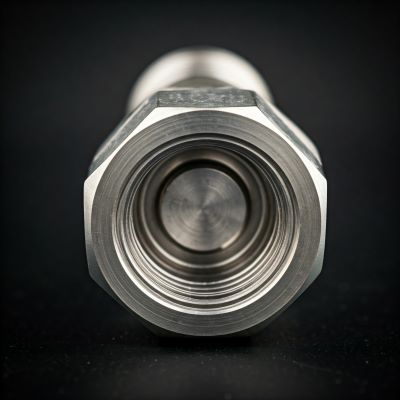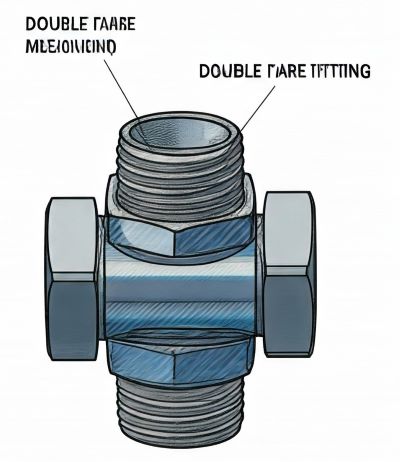Flare fittings are a common type of connection used in fluid and brake line systems. They create a leak-proof seal by using a flared end on the tubing, which is then inserted into a matching fitting. Flare fittings are essential for ensuring the safe and efficient operation of various systems, from automotive brake lines to hydraulic systems.
Choosing the right type of flare fitting is crucial for several reasons. First, it ensures a secure and leak-proof connection. Second, it helps to prevent system failure, which can be dangerous in some applications. Third, it can help to extend the life of the system by reducing wear and tear.
Brief introduction to inverted flare and double flare
The two most common types of flare fittings are inverted flare and double flare. Both offer reliable sealing, but they differ in their design, strength, and application.
What Is an Inverted Flare?
➡️ Definition and design: Inverted flare fittings have an internal bevel on the tubing, creating a flared end that fits into a mating fitting with a corresponding external bevel.
➡️ How inverted flares work in sealing connections: The flared end of the tubing is inserted into the fitting and then tightened. This creates a tight seal by compressing the flared tube against the mating surface of the fitting.
➡️ Common materials and applications: Inverted flares are typically made of metal, such as steel or brass, and are commonly used in automotive and industrial applications.
What Is a Double Flare?
➡️ Explanation of the double flare and its unique features: Double flare fittings have an internal and external bevel on the tubing. The flaring process creates a two-stage flare, resulting in a stronger and more reliable seal.
➡️ How double flares provide additional strength and sealing: The double flare creates a more robust connection due to the increased contact area between the tubing and the fitting. This also enhances the seal’s resistance to vibration and high pressures.
➡️ Common uses and industries that rely on double flares: Double flare fittings are commonly used in high-pressure applications such as automotive brake lines and hydraulic systems.
Key Differences Between Inverted Flare and Double Flare
➡️ Structural differences: Inverted flares have a single internal bevel, while double flares have both internal and external bevels.
➡️ Strength and durability: Double flares generally offer greater strength and durability than inverted flares, especially in high-pressure applications.
➡️ Applications where one is preferred over the other: Inverted flares are suitable for lower pressure applications, while double flares are preferred for higher pressure applications.
Inverted Flare vs Double Flare: Advantages
Advantages of Inverted Flare
➡️ Ease of installation and maintenance: Inverted flares are generally easier to install and maintain than double flares.
➡️ Reliable sealing for medium-pressure systems: They provide reliable sealing for most automotive and industrial applications.
➡️ Compatibility with standard fittings: Inverted flare fittings are widely available and compatible with a variety of standard components.
Advantages of Double Flare
➡️ Enhanced strength for high-pressure applications: Double flares offer superior strength and durability for demanding applications.
➡️ Greater resistance to cracking under stress: They are less susceptible to cracking under high pressures or vibrations.
➡️ Ideal for automotive brake lines and hydraulic systems: Double flares are commonly used in these applications due to their enhanced performance.
How to Choose Between Inverted Flare and Double Flare
➡️ Factors to consider: Consider factors such as the operating pressure, the application requirements, and the materials being used.
➡️ Pros and cons of each option for specific use cases: Evaluate the advantages and disadvantages of each flare type for your particular application.
➡️ Expert tips for making the right decision: Consult with a qualified professional or refer to industry standards for guidance.
Installation and Maintenance Tips for Flare Fittings
➡️ Tools required for proper installation: Flaring tools, wrenches, tubing cutters, and appropriate safety equipment are required.
➡️ Step-by-step guide to creating inverted and double flares: Follow the manufacturer’s instructions carefully and ensure proper flaring techniques are used.
➡️ Maintenance practices to ensure long-lasting connections: Regularly inspect fittings for leaks, signs of wear, and corrosion.
Conclusion
Choosing the right flare fitting is critical for the safe and reliable operation of fluid and brake line systems. By understanding the differences between inverted flare and double flare fittings and considering factors such as pressure and application, you can make an informed decision and ensure optimal system performance.
Remember to consult with professionals for complex systems and always prioritize safety during installation and maintenance.
Post time: Jan-10-2025



